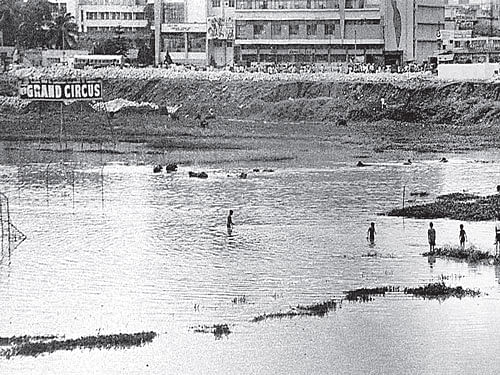
Dharmambudhi tank / lake was once a major water body opposite the city railway station, right at the spot where the BMTC and KSRTC bus stations are now located. It was once the most critical water source for people in the old city’s Pete region. The tank was connected to all open wells around it, to small tanks, and to small lakes a few kilometres away and was the cleanest source of drinking water. So what happened to this link?
“This tank, more than a 100 years old, would re-charge all the tanks and lakes around it. The existence of channels and pathways for water to circulate to different locations in the city reveals the water management plans even then were brilliant. The engineering sense you get from the all-round connectivity is a reflection of capabilities at the time. The landscape now is completely different and so are the sensibilities,” says environmentalist and civil engineering expert Yellappa Reddy.
The tank used to serve essential tasks of the day such as bathing, washing vessels, conducting poojas, cooking and drinking. The water was said to be so pure that people would collect it directly from the wells and percolation tanks connected to the lake. The recharging of water by the lake indicates its importance as a crucial ecosystem in the early days of colonial Bengaluru. “We had good technical people even then. For those times, the system that they devised to distribute water to other tanks and lakes was good. Due to development and rise in population, the lake began to shrink gradually,” recalls Reddy.
According to S Srinivas, a blogger, in 1877 when famine struck the Mysore state, the government took up the desilting work of the Dharmambudhi tank to provide jobs. In the process, the tank’s supply channels were repaired, leading to increased supply of good drinking water to the inhabitants of the pete (city).
Lack of maintenance in the subsequent years led to shrinking of water in the tank. During 1892-93, when monsoons failed, Bengaluru witnessed water shortage. The government pumped water from the springs in the Jakkarayana tank valley into the Dharmambudhi tank. Also about 23,20,000 gallons of water was pumped into the tank from the Hebbal tank. Says Srinivas, “The term pumping here probably meant to let water flow from one tank to another via channels through gravity. In this case, it was probably from Hebbal tank to Sankey tank and from there to Dharmambudhi tank via Jakkarayanakere (the present BBMP playground on Platform Road). From 1896 onwards, Bengaluru town was supplied with piped water from the Hesaraghatta reservoir. This made the municipality neglect maintenance of the Dharmambudhi tank, which became completely dry.”
When water supply completely dried up, Dharmambudhi tankbed became a hub of public meetings. “In 1931, Jawaharlal Nehru addressed a meeting here and hoisted the tricolour. Exhibitions and shows were also held here at regular intervals. In 1963, the government handed over 1,36,294 square yards of land of the Dharmambudhi tank bed to KSRTC to construct a bus stand,” informs Srinivas.
G Krishnaprasad, a long-time resident of Seshadripuram and a frequent visitor to the lake in the 1950s, agrees that the lake area was transformed into a public space when it could no longer meet Bengaluru’s drinking water needs. “I remember having gone to see the circus and exhibitions at one corner of the tank. The circus, in particular, was the most important entertainment for people of Bengaluru 40-50 years back. I also remember people playing cricket. There was a small bus stand too, from where around 30- 40 buses would operate. All this was possible because the lake was drying up. The question then was what do we do with the open space? While there was the lake, some part of it which was dry would be utilised for entertainment purposes and public activity.” The transformation then, of the lake into a bus station, soon became permanent.